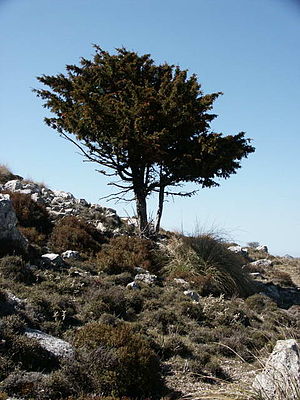Note: This is a project under development. The articles on this wiki are just being initiated and broadly incomplete. You can Help creating new pages.
Taxus baccata
Taxus globosa is an evergreen shrub or a tree that can grow up to 4.6 metres tall, with specimens up to 15 metres reported in the highlands of Guatemala. The tree is sometimes harvested from the wild for local use as a food and source of wood. It is a potential source of the anticancer drug 'taxol'.
Contents
[hide]- 1 Uses
- 2 Parts Used
- 3 Chemical Composition
- 4 Common names
- 5 Properties
- 6 Habit
- 7 Identification
- 8 List of Ayurvedic medicine in which the herb is used
- 9 Where to get the saplings
- 10 Mode of Propagation
- 11 Season to grow
- 12 Soil type required
- 13 Ecosystem/Climate
- 14 How to plant/cultivate
- 15 Commonly seen growing in areas
- 16 Photo Gallery
- 17 References
- 18 External Links
Uses
Parts Used
Chemical Composition
It contains P-hydroxybenzoic acid (1), putraflavone (2), sequoiavone (3), 7, 13-dideacetyl-9, 10-debenzoyltaxchinin C (4), baccatin VI (5) and taxumairone etc.[2]
Common names
| Language | Common name |
|---|---|
| Kannada | |
| Hindi | Gallu, Thuno |
| Malayalam | |
| Tamil | |
| Telugu | |
| Marathi | Barmi |
| Gujarathi | |
| Punjabi | |
| Kashmiri | |
| Sanskrit | Manduparni |
| English | Himalayan Yew |
Properties
Reference: Dravya - Substance, Rasa - Taste, Guna - Qualities, Veerya - Potency, Vipaka - Post-digesion effect, Karma - Pharmacological activity, Prabhava - Therepeutics.
Dravya
Rasa
Guna
Veerya
Vipaka
Karma
Prabhava
Habit
Identification
Leaf
| Kind | Shape | Feature |
|---|---|---|
Flower
| Type | Size | Color and composition | Stamen | More information |
|---|---|---|---|---|
| {{{5}}} |
Fruit
| Type | Size | Mass | Appearance | Seeds | More information |
|---|---|---|---|---|---|
Other features
List of Ayurvedic medicine in which the herb is used
Where to get the saplings
Mode of Propagation
Seeds, Cuttings of half-ripe terminal shoots, Air layering, Cuttings of ripe terminal shoots.
Season to grow
Winter.
Soil type required
Suitable for light (sandy), medium (loamy) and heavy (clay) soils, prefers well-drained soil and can grow in heavy clay soil. Suitable pH: acid, neutral and basic (alkaline) soils and can grow in very acid and very alkaline soils.[5]
Ecosystem/Climate
Taxus baccata grows best in the high humidity of mild oceanic climates.[6]
How to plant/cultivate
Taxus globosa is moderately cold hardy, tolerating occasional, short-lived temperatures falling to between -12.1°c and -6.7°c.[7]
Commonly seen growing in areas
Montane forest, Pine-oak forest.
Photo Gallery
In Arlós, Llanera, Asturias in Spain
Barlind - from Botanical Garden Bergen Museum in Norway
References
- Jump up ↑ Indian Medicinal Plants by C.P.Khare
- Jump up ↑ Chemical constituents
- Jump up ↑ Local names
- Jump up ↑ [Morphology]
- Jump up ↑ Soil type required
- Jump up ↑ Ecosystem
- Jump up ↑ Cultivation details
External Links
- Ayurvedic Herbs known to be helpful to treat Cancer
- Herbs with Fruits used in medicine
- Herbs with Bark used in medicine
- Herbs with common name in Hindi
- Herbs with common name in Marathi
- Herbs with common name in Sanskrit
- Herbs with common name in English
- Habit - Evergreen tree
- Index of Plants which can be propagated by Seeds
- Index of Plants which can be propagated by Cuttings of half-ripe terminal shoots
- Index of Plants which can be propagated by Air layering
- Index of Plants which can be propagated by Cuttings of ripe terminal shoots
- Herbs that are commonly seen in the region of Montane forest
- Herbs that are commonly seen in the region of Pine-oak forest
- Herbs







